{{tip-component-1}}
The United States is strengthened by international perspectives. A key part of that equation involves supporting, investing in, and welcoming international students to college campuses. The U.S. has historically been a top destination for students, driven by opportunities for research, professional growth, and cultural exchange.
“What has made America great is its monopoly on dreamers from all around the world,” says Xiao Wang, founder and CEO of Boundless Immigration. “My parents gave up everything to come and study in the U.S. because they felt that this is the place that had the most opportunity.”
Yet, recent actions by the Trump administration — including heightened scrutiny and visa challenges for students at institutions like Harvard — reflect a broader crackdown that could jeopardize this long-standing appeal.
International students are also a barometer of the lingering effects of the COVID-19 pandemic, the impact of changing rhetoric and policies affecting immigrants, and perceptions of the United States on the global stage.
By examining the contributions and trends of international students in the United States, policymakers, educators, and employers can better understand the power of staying connected both at home and abroad.
A Look at International Students in the U.S.
International student mobility refers to the enrollment of international students in proportion to total students in the host country. In 2024, there were more than 1.5 million international students enrolled in the United States, making up 5.5% of the total U.S. student body.
The Student and Exchange Visitor Program (SEVP), part of U.S. Immigration and Customs Enforcement’s (ICE) Homeland Security Investigations division, identifies international students as “nonimmigrants” — that is, any foreign national who temporarily visits the United States to fulfill a specific purpose, such as business or study.
Nonimmigrant students are eligible for the following visas:
- F-1 students: Those who enroll in an academic course of study at an SEVP-certified school or program
- M-1 students: Those whose primary purpose is to complete a vocational course of study at an SEVP-certified school or program
- J-1 exchange visitors: Those selected to participate in a U.S. Department of State-designated exchange visitor program

In 2024, international students in the United States came from more than 229 countries and represented every continent in the world, with the exception of Antarctica. Due to the large number of students coming from China and India, more than 70% of international students in the U.S. were from Asia. All six continents saw an increase in the number of students coming to the United States. We explore some of the potential reasons below.

In December 2024, Duolingo published its annual language learning trends report, highlighting key changes in global behavior and interest. A notable finding was the continued rise of English as the most studied language worldwide, ranking number one in 135 countries — an increase of more than 10% compared to 2023. Countries like Albania, Eritrea, Iran, and Rwanda saw English leap to first place in their rankings.
Historically, these countries have not been top countries of origin for students entering higher education in the United States. According to Duolingo, this trend suggests more students from a wider geographic range are pursuing international higher education opportunities, perhaps benefitting from the increased accessibility of affordable, online language learning tools like Duolingo.
Top Areas of Study for International Students
Most international students come to the United States to enroll in higher education — specifically, SEVP-certified associate, bachelor’s, master’s, or doctoral programs. The majority pursue degrees in STEM fields (science, technology, engineering and math), as well as business and management.
In the 2023-2024 academic year, the 10 most popular fields of study, based on a student’s primary major, were as follows:

Top Institutions for International Students
To maintain their visas, F-1 students must attend schools that are SEVP-certified. In 2024, ten U.S. universities enrolled the largest numbers of international students, led by New York University, Northeastern University, and Columbia University.
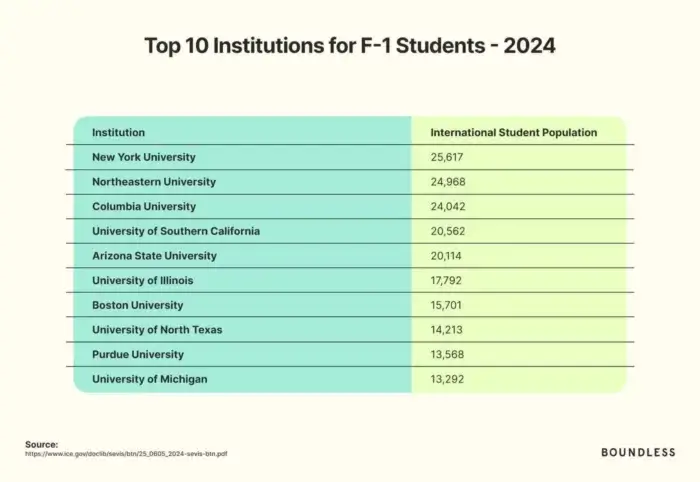
Where International Students Call Home in the United States
International students study across the country, but nearly half are concentrated in California, New York, Texas, Massachusetts and Florida.
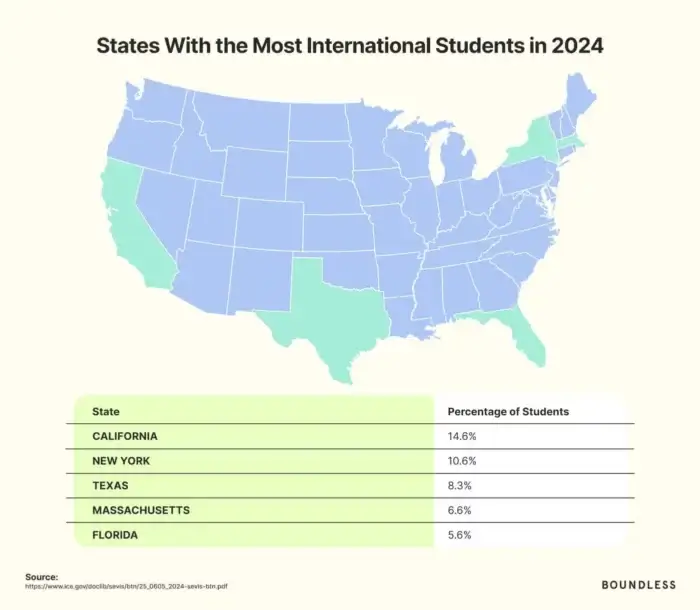
Contributions of International Students in the U.S.
The economic impact of international students is significant. They contributed $43.8 billion to the U.S. economy and supported 378,175 jobs during the 2023-2024 academic year. But their influence extends beyond the economy; they also enhance the intellectual and cultural environment on U.S. campuses. These relationships and experiences can have long-term impacts on personal, socioeconomic, and even political levels.
“International students aren’t just filling seats in classrooms. They’re fueling our economy for the next generation, launching startups and solving problems in science, technology, and healthcare,” notes Wang. “Pushing them away is like turning off a tap that feeds American growth.”
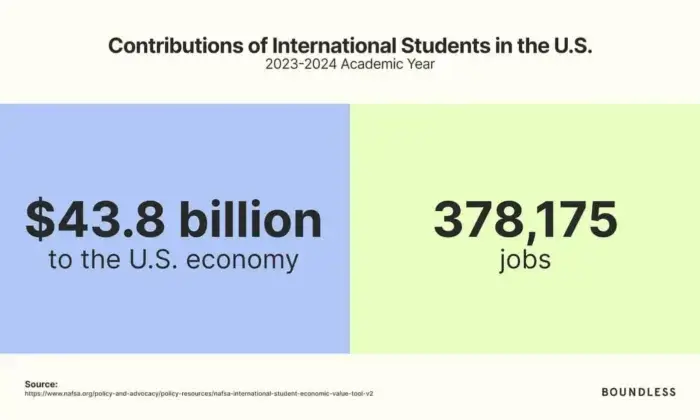
Researchers at Duke University surveyed alumni from several universities roughly 5, 10, and 20 years after graduation. The study found that U.S. students who actively interacted with international students reported better self-confidence, leadership, quantitative skills, and overall intellectual growth. Later in life, participants were more likely to appreciate art and literature, place current problems in historical perspectives, read or speak a foreign language, reexamine their political and religious beliefs, and reassess their beliefs about other races or ethnicities.
“A larger number of international students on campus could provide more opportunities for domestic students to interact across cultures and challenge their existing belief and value systems,” the researchers wrote.
According to a 2023 report by the UK-based Higher Education Policy Institute (HEPI), the United States is the most popular place of study for overseas students who later go on to lead in their home countries. This is significant because research has found that when international students develop positive relationships with their host countries, they’re more likely to visit in the future and do business with that country.
HEPI researchers wrote, “Growth in the number of people crossing borders for higher education has been so strong in recent years that any country that is not increasing its numbers significantly is falling back against its competitors in terms of global share.”
Optional Practical Training
Optional Practical Training (OPT) is a program that allows international students on F-1 visas to work temporarily in a field related to their major area of study. Students may apply for up to 12 months of OPT either during their studies (pre-completion OPT) or after completing their degree (post-completion OPT). For students in certain STEM (Science, Technology, Engineering, and Mathematics) fields, there is an opportunity to extend the OPT period by an additional 24 months. OPT provides valuable work experience and is often a step toward longer-term employment in the U.S.
{{tip-component-2}}
Changes in International Student Enrollment Over Time
The COVID-19 pandemic had a marked impact on international student enrollment, but in 2024, enrollments continued to rebound.
According to SEVP, there were 1,582,808 active records for F-1 and M-1 students in 2024 — a 5.3% increase from 2023. All four regions of the U.S. — the Northeast, Midwest, South, and West — saw an increase in international student records of between 1% and 9%. As in 2023, the South saw the greatest increase at 8.5%, followed by the Midwest with 5.9%.
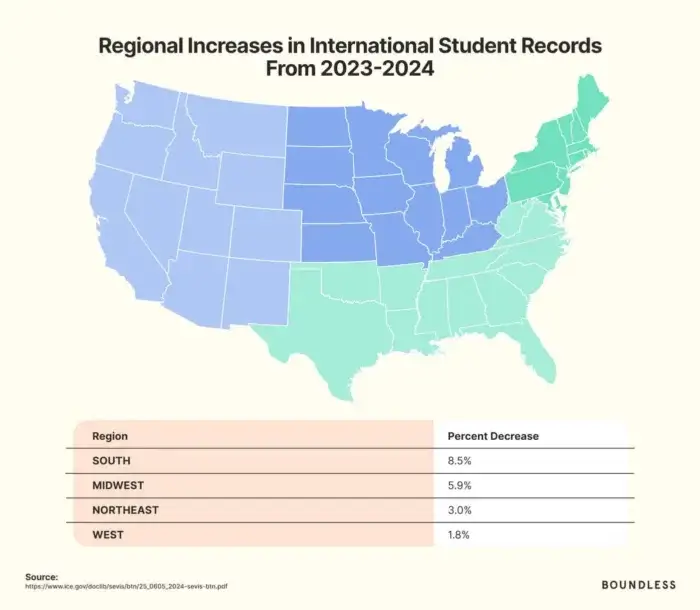
This trend was true across all degree programs in the 2023-2024 school year, with associate degree programs (9.8%) and master’s programs (9.7%) experiencing the largest increases.
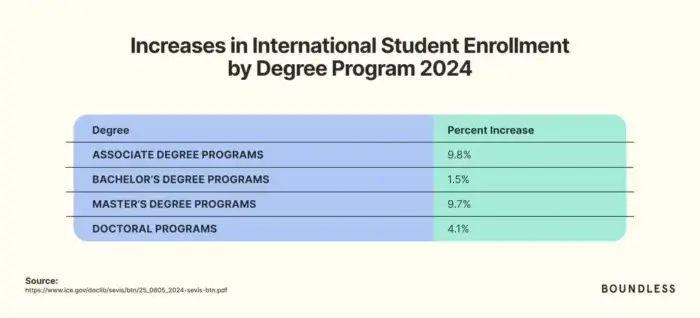
Why More International Students Chose to Study in the United States in 2024
After a drop in international student enrollments during the COVID-19 pandemic, numbers rose in 2023 and continued to climb in 2024, though at a slower pace.
Several factors helped drive growth:
- Increased outreach: According to a 2023 survey by the Institute of International Education (IIE), 92% of colleges and universities said they hoped to increase their international student population and 85% said their funding to recruit more international students was the same or higher than the previous year. One reason for this focused effort to entice more international students is the drop in domestic enrollment — since 2010, the number of American-born students enrolling in undergraduate study has decreased by 10%.
- More capacity: Other countries have a limited number of higher education institutions, or they are running out of capacity to accommodate international students. According to the IIE, Canada and the United Kingdom have reached 22-30% of their capacity to host international students. In contrast, international students make up just 6% of higher education enrollment. “With almost 4,000 higher education institutions, the United States has the greatest capacity to host international students,” IIE researchers wrote.
- End of COVID-19: The coronavirus pandemic brought travel to a virtual standstill. Once global travel restrictions eased, U.S. campuses saw international enrollments rebound. According to a 2021 survey by the Council of Graduate Schools, which looked specifically at masters and doctoral programs, the sharp drop-off in international enrollment from fall 2019 to fall 2020 was fueled more by health and travel issues than a drop in interest.
- Policy shifts and political rhetoric (historical context):In 2020, researchers from Central Michigan University examined “the Trump effect” — the net effect of the Trump administration’s policies, anti-immigrant rhetoric, and shifting requirements for both students and colleges. Although international student enrollment was already declining prior to Donald Trump taking office, new international student enrollment decreased by 6.6% in the 2017-2018 academic year and 0.9% in the 2018-2019 academic year.
At the same time, other trends slowed overall growth:
- Fewer visas issued: The U.S. government issued 401,000 student visas in 2024, 10% fewer than in 2023.
- Political climate (current): The run-up to the 2024 U.S. presidential election began in the spring, and the accompanying negative rhetoric surrounding immigration may have contributed to a sense of uncertainty and discomfort, causing would-be students to think twice about studying in the U.S.
How the U.S. Compares to Other Top Study Destinations
The U.S. continues to host the largest number of international students globally, with over 1.58 million in 2024, accounting for about 16% of the world’s internationally mobile students. In comparison, Canada hosted nearly 1 million (about 997,820) international students and the United Kingdom 732,285 in the 2023-24 academic year. However, international students make up a smaller share of total higher education enrollment in the U.S. (around 6%) compared to much higher proportions in the UK (over 25%) and Canada (up to 39%).
Enrollment trends show the U.S. remains resilient amid global competition and shifting student flows. While Canada, the UK, and Australia have seen recent declines or stagnation — driven by policy changes, capacity limits, or visa restrictions — the U.S. has sustained growth in its international student population and holds the world’s largest higher education sector by capacity and diversity of institutions.
Looking Ahead
2025 is shaping up to be a year of change for international student enrollment in the U.S. The combination of more restrictive immigration enforcement actions and politically charged narratives is already driving away international students who might otherwise have sought higher education opportunities in the U.S. This has been intensified by the Trump administration’s high-profile actions against Harvard, including attempts to revoke its SEVP certification and suspend student visas. In addition, the Trump administration has so far this year revoked more than 6,000 student visas across the country, adding to the climate of volatility.
Although court intervention has temporarily halted some of these measures, the aggressive enforcement policies are creating major uncertainty for international applicants, prompting many to look to countries with less political volatility or more favorable visa policies. Recent survey data from IDP Education underscores this trend: the proportion of students considering only the U.S. for study has fallen from 32% to 26%, with interest in Canada, the U.K., and Australia steadily increasing.
The implications of such a shift are far-reaching. A new report from the non-profit National Foundation for American Policy found that, without immigrants and international students, U.S. colleges could lose millions of enrollees and face widespread closures, particularly among regional and mid-tier schools. Such closures would reduce educational options for American students and cut jobs in communities that rely on local universities.
In addition, one of the primary benefits of hosting international students is the opportunity it provides for cultural exchange and global engagement. When students from diverse backgrounds come together on U.S. campuses, they enrich the academic environment and challenge their peers to broaden their perspectives. U.S. citizens and students also stand to benefit, gaining exposure to new cultures, belief systems, and ways of thinking. The presence of international students fosters cultural competence and global-mindedness, qualities that are increasingly important in an interconnected world.
In this context, international students are integral to the fabric of U.S. campus life and, by extension, to the broader American culture. Their contributions extend beyond academia, influencing the social, political, and economic landscape of the country. If current political trends persist, the U.S. risks losing these invaluable exchanges, a loss that would ultimately weaken higher education institutions and diminish the cultural and intellectual richness of the nation.
“Every data point in this report tells the same story: International students want to be here,” says Wang. “The real question is whether the United States will keep the door open, or send a message that says, ‘You’re not welcome.'”
About the Data
The following public sources were used:
- https://www.ice.gov/doclib/sevis/btn/25_0605_2024-sevis-btn.pdf
- https://www.nafsa.org/policy-and-advocacy/policy-resources/nafsa-international-student-economic-value-tool-v2
- https://blog.duolingo.com/2024-duolingo-language-report/
- https://www.applyboard.com/applyinsights-article/number-of-us-f-1-visas-issued-steadied-in-fiscal-year-2024
- https://www.applyboard.com/applyinsights-article/how-stem-talent-powered-the-us-international-education-sector-in-2024
- https://www.iie.org/wp-content/uploads/2024/03/IIE_Outlook-2030_March-2024-1.pdf
- https://www.hepi.ac.uk/2023/08/22/over-one-quarter-of-the-worlds-countries-are-headed-by-someone-educated-in-the-uk-and-another-quarter-are-headed-by-someone-educated-in-the-us-hepi-2023-soft-power-index/
- https://www.britishcouncil.org/sites/default/files/sources-soft-power-report-perceptions-success.pdf
- https://opendoorsdata.org/data/international-students/fields-of-study/
- https://files.eric.ed.gov/fulltext/EJ1056457.pdf
- https://today.duke.edu/2013/06/internationalengage
- https://www.iastatedigitalpress.com/jctp/article/id/11588/
- https://monitor.icef.com/2025/03/full-year-data-highlights-decline-in-foreign-enrolment-in-uk-universities-in-2023-24/
- https://cbie.ca/media/facts-and-figures/international-students/
- https://nfap.com/research/new-nfap-policy-brief-the-importance-of-immigrants-and-international-students-to-higher-education-in-america/
- https://partners.idp.com/usa/articles/education-sector-news/student-sentiment-shifts-as-the-u-s-policy-uncertainty-grows
- https://www.boundless.com/blog/student-visa-social-media-screening/
- https://www.boundless.com/blog/trump-administration-revokes-harvards-ability-to-enroll-international-students/
- https://www.nbcnews.com/news/us-news/trump-administration-revoked-6000-student-visas-state-department-says-rcna225757
- https://www.nytimes.com/2025/08/14/business/us-international-students-trump.html

.svg)
.avif)